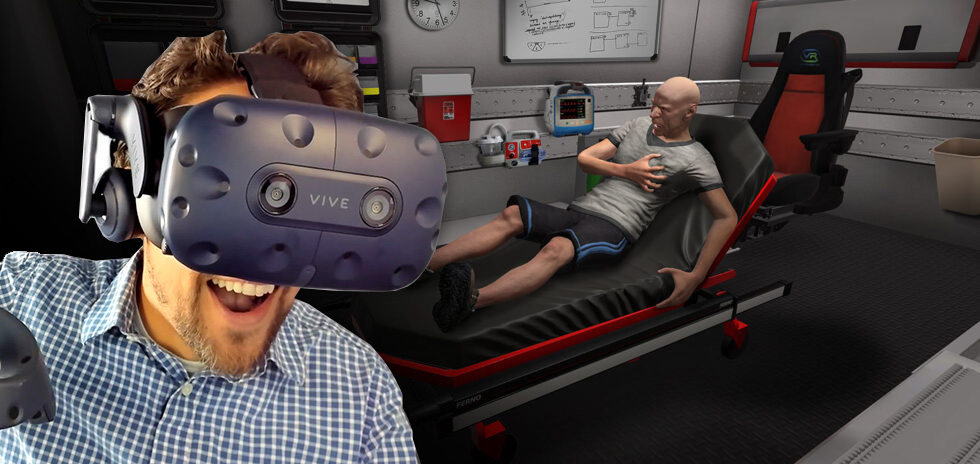
For a long time, education meant students listening to a teacher giving a lecture.
Then came computers and everything changed.
Now virtual reality is transforming education again.
“It’s a whole new world. It’s living in the environment and not sitting there reading a book,” says Tom Cox about VR. Cox is former paramedic and training director who’s been active in the EMS industry in many capacities for over 30 years. He’s currently the Director of EMS sales for VRpatients, the online virtual EMS training application that allows you to build your own clinical case scenarios.
“There are studies out there talking about better recall and better retention of material just because students have a VR headset on. I just think that it’s more fun. They’re more involved and it’s more like everyday life. People look forward to it and it’s something different.”
Using virtual reality in EMS training and other educational settings has both pros and cons.
What Can VR Do in Education?
Virtual reality allows students to engage multiple senses in a three-dimensional computer-generated environment.
“In the case of medical simulation, it raises your blood pressure and makes you think. It gives you a more real-life experience than sitting there looking at something that’s 2D,” Cox explains. “It speaks to the dizziness that some people get when they experience virtual reality the first few times. Their senses aren’t ready for it.”
Basically, it brings a simulated environment to life so students don’t just see something, but also experience it.
Using VR began in the gaming sector and quickly expanded to education.
Tools like VRpatients are using advanced VR technology to train current and future EMS workers.
“As EMS students come out of their classes, there needs to be a lot of patient contact before those new medics really gain some expertise at their job. I think that with virtual reality, you can experience more patients more often and therefore feel more prepared because you’ve seen all this stuff and you’ve done all this stuff in virtual reality. I just think that it better prepares somebody to face the realism of being in the field and seeing a real patient,” Cox says.
There are several different ways to use VR training for business and educational purposes.
- Scenario based: Using scenarios and simulations, VR can place people into real situations to see how they react.
- Technical training: Walking students through technical and complicated procedures and protocols to gain practice.
- Onboarding: Learning about an organization and its protocols and procedures.
- Safety training: Practicing dangerous situations without real consequences and risks.
“VR is a good substitute. It will never replace a real live patient, but it will prepare you to better handle that real life patient experience,” Cox says. “I’m a firm believer that you make your mistakes with the avatar or with the patient in a VR environment. Don’t make the mistakes when you’re with a real patient. I just think preparing with VR leads to confidence. It’ll never be the same, but it’s a heck of a lot closer than anything we’ve ever used before to prepare you for that real-life patient.”
Using VR in education can enhance the traditional lecture by making it more memorable and entertaining for students, especially younger students who grew up with technology and are used to it in their lives.
For the most part, people would rather watch something that read something so using VR in education can definitely enhance the educational experience.
“It changes your attitude. If you’re having fun doing something, it’s a lot easier to learn than if you’re not having fun and it’s looked at as a chore,” Cox says. “I’d much rather experience something in virtual reality than open a book and try to read about the same subject.”
Pros of Using VR in Education
In addition to making the learning experience more collaborative and interactive, there are many other reasons to use VR in education.
- Simplify: VR can simplify a learning experience and make it useful to students. Instructors can expose students to situations they might not regularly see to find out what choices they will make.
- Safety: Can allow students to make mistakes and learn from them without harming real people. This is especially important in EMS training.
- Testing: Instructors can put a variety of students into the same situation to see how each responds. As students improve, instructors can create new situations and raise the stakes.
- Analytics: Not only can VR show instructors how their students respond in certain situations, VR can also collect metrics and behavioral data to show learner engagement. Sensors can show where a student is looking, how their eyes stay focused, gestures they make, and more.
- Distance: Students who might not have the opportunity to attend classes because they are geographically disadvantaged might have the opportunity to attend with distance learning that uses VR.
“Instructors have the capability to evaluate the skills of the masses and not just one student at a time. I think one of the issues that we have in live training is the introduction of subjectivity into grading,” Cox says.
An instructor can only pay attention to one student at a time and another student might be making mistakes and the instructor doesn’t notice.
“With an online product or a virtual product, an instructor can assign the same case to many students who can all run it and they can all be graded very objectively. When the case is done, the instructor can review, step by step, with each student, what they did and what maybe they could do better next time.”
Cons of Using VR in Education
While virtual reality has many benefits in the education realm, there are also drawbacks.
Initially, there can be a high cost to implementing VR into current curriculum. Headsets and other equipment can be expensive. There’s also always the risk that if you buy today, something better will come out tomorrow.
If an entire training curriculum is based on VR and the technology breaks down for some reason, learning would stop. There can also be a disparity between departments that have the latest and greatest technology and those that do not.
Some people complain about a lack of human interaction that can come with using VR and other technologies in educational settings. The feedback often comes from a computer instead of a person.
Since people learn differently, it can sometimes be difficult to understand what someone did well or what they did wrong without human interaction. A human instructor can often tell if someone isn’t understanding something by the look on a student’s face. A computer cannot see that, and a student cannot stop the instruction to ask a question.
Then there are the physical effects some people have when using virtual reality which can include:
- Vertigo and dizziness
- Nausea
- Headaches
- Stumbling over real objects they can’t see when immersed in a virtual world.

“It’s something I think you have to take in little pieces until you get used to it. But once you get used to it, your body starts to adapt,” Cox says, remembering the first time he tried VR for a space station program. “It made me feel weightless and within five minutes I had to take the headset off because I was becoming nauseous. You feel like astronauts must feel. It’s a real experience. I went back and did it two or three times and I started getting a little bit more used to it.”
Practicing scenarios and situations in a virtual world can also give students a sense of overconfidence. Just because they have seen a situation in training doesn’t mean they are ready for it in real life.
No matter how real VR feels it isn’t.
“Something that will never change in an EMS class is you still have to teach people the basics like how to start an IV and put on a blood pressure cuff and instructors need to figure out the best ways to teach those skills, Cox says. “You actually need to feel the needle puncture the skin and right now with the VR technology, that is difficult to do. You still need hands-on classroom experience. I can’t give you that practice inside VRpatients, but I can assess your knowledge of when and how to do certain procedures.”
When you’re ready to look for a VR solution to your training needs, look no further than VRpatients.
As an industry leader navigating the remote learning world, the people at VRpatients know you are always looking to optimize your educational toolset. VRpatients increases knowledge retention and builds stress inoculation, all for a fraction of the price of traditional sim training.
Contact us to schedule a demo or to learn more about how VRpatients can help you get the most out of your precious training dollars – for less than $10 per month per student.
